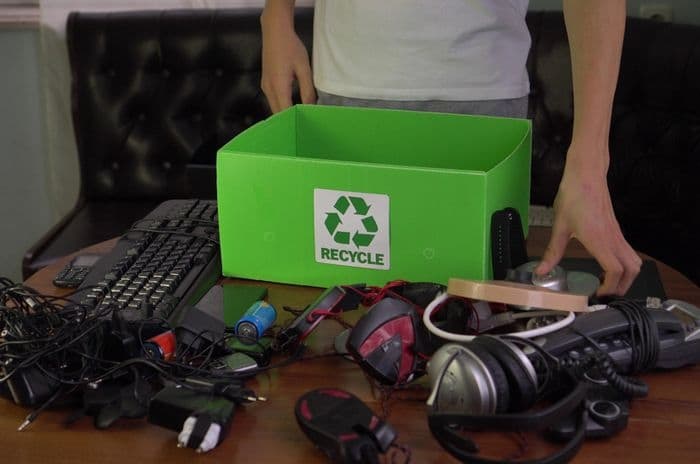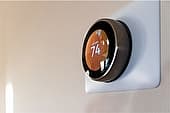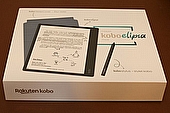Home > News > Less than 16% of electrical goods waste gets recycled
Less than 16% of electrical goods waste gets recycled
ALMOST 42 million tonnes of electronic waste - old household electricals of all shapes and sizes, computer equipment, mobile phones, and lamps - was thrown away last year.

According to a report from the United Nations University, less than 16% - only 6.5 million tonnes - of electronic waste created around the world in 2014 was disposed of through official collection, recycle and reuse schemes.
The report [pdf], published by the Institute for the Advanced Study of Sustainability found that while Europeans are the largest per capita generators of e-waste in the world, they do at least dispose of around 40% correctly - although some 0.7 million tonnes of the stuff, roughly 8% of the annual amount, goes straight into Europe's bins.
In the UK we generated an average of 23kg of e-waste per person, adding up to 1.5 million tonnes in total. The only European nation to generate more was Germany, which produced 1.8 million tonnes.
So where does our electrical waste go, and where should it be going?
What counts as e-waste?
Pretty much anything that takes batteries or has a power cable, and that is discarded without the intention of being re-used, counts as e-waste, or to give it its full title: "Waste Electrical and Electronic Equipment" (WEEE).
While most of us are guilty of throwing the odd AA battery in the kitchen bin, the vast majority of the e-waste created in the UK and elsewhere is in the form of much larger items.
Old washing machines, dishwashers, electric cookers, and similarly sized items make up 28% of the goods dumped, in weight terms; household goods ranging in size from vacuum cleaners to electric shavers accounting for another 31% of the total weight.
Monitors - ranging from flat screen TVs to tablets, notebooks and laptops, to traditional computer screens - account for just 6.3 million tonnes of the global e-waste pile.
Unsurprisingly, given their size and weight, small IT - phones, GPS units, routers - and PCs and printers - only make up about 7% of the total waste.
The 'right' way
What's supposed to happen is this:
All e-waste is gathered to be taken to a state-of-the-art treatment facility, where it's dismantled and stripped of valuable materials to be re-used, and any harmful waste disposed of carefully and safely.
Local government, retailers, and other organisations have a legal responsibility to provide recycling facilities.
Most supermarkets and home goods stores have battery recycling points, while stores selling larger appliances must offer some form of take-back system - either their own, or provided in conjunction with a distributor.
Disposal should be offered free of charge - although that can be as simple as setting up a collection point in-store for smaller equipment.
But the "free of charge" part also means that any retailer offering delivery and removal shouldn't charge any more for the collection part of the service than they would for delivery and/or installation alone.
Every local council will offer some form of e-waste disposal service, but in most places this depends on people taking their old items to one-stop refuse and recycling locations that would once simply have been the local takes-everything dump.
Take-up of these services therefore tends to rely on people having transport, and being able to get to the facilities when they're open.
For anyone who's got more than they can carry easily, many councils do offer collection services, but what they will take away - and how much they charge for doing so - varies across the country.
In 2012, the last year for which the UN report had figures, official take-back schemes like these collected 504,000 tonnes of e-waste - about a third of the total amount generated.
Other methods of disposal
But many people simply throw batteries in the bin, along with some of the larger small items - old phone chargers, lamps, cameras and so on.
All together, it's reckoned a further 394,000 tonnes of e-waste was dumped this way - equivalent to each of us throwing 6.33 kg of batteries in the rubbish.
Then there are the independent collection schemes run by individual dealers and companies such as office equipment recycling businesses and firms that specialise in items like air conditioners and industrial-scale e-waste.
After collection, all kinds of things can happen to it.
Some of it will be refurbished and resold - as with the local schemes that make computers available to people at low cost.
Included in this category are the charities that offer to take away old white goods - again, some with the intention of refurbishing and selling or passing them on.
About 10% is sent for recycling - through both specialised e-waste facilities and standard recycling services.
A large part of it, however, is sent to pre-processing plants, where some parts will be salvaged and the rest will be separated roughly according to what material it's made of.
From there, the roughly sorted waste is sent on to refineries and recycling centres as above, or prepared for export.
It's estimated that as a result of this type of disposal, about 30% of British e-waste ends up being put into the metal recycling stream.
Meanwhile, the UN report suggests around 5% is exported for re-use or recycling elsewhere, with a substantial amount traded to developing or less developed nations, where there is a huge demand for inexpensive, second hand equipment, and the raw materials contained in them.
Smart technology, dangerous waste
Short product lifespans may well have something to do with the amount of waste generated - but as we've covered here, there's a certain amount of vanity replacement going on as well.
WRAP figures from 2014 suggest that almost a quarter of the electrical equipment taken to UK household recycling centres, worth an estimated £200 million, could easily be re-used.
Newer goods may or may not last as long as they used to, but they're increasingly reliant on smart technology, which requires small amounts of some incredibly precious elements.
WRAP reckon the UK will buy an estimated 10 million tonnes of electrical equipment from 2014 to 2020 - and tucked inside those products will be 20 tonnes of gold, 400 tonnes of silver and seven tonnes of "platinum group" metals.
Globally, the amount of precious and potentially hazardous elements being lost to poor disposal methods is even more staggering. In 2014, the UN say, some 300 tonnes of gold was lost to landfill and incineration. That's equivalent to more than 10% of world gold production in 2013.
But recovering the tiny amounts of precious metals and other substances trapped in the components of old mobiles and computers is only economically viable if it's being done on a grand scale.
When the next round of WEEE regulations come into force, in 2019, all EU member states are supposed to be recycling at least 85% of their e-waste.
At present only three countries - Sweden, Denmark, and Bulgaria - collect and recycle more than 60%.
Get insider tips and the latest offers in our newsletter

We are independent of all of the products and services we compare.

We order our comparison tables by price or feature and never by referral revenue.

We donate at least 5% of our profits to charity, and we aim to be climate positive.





